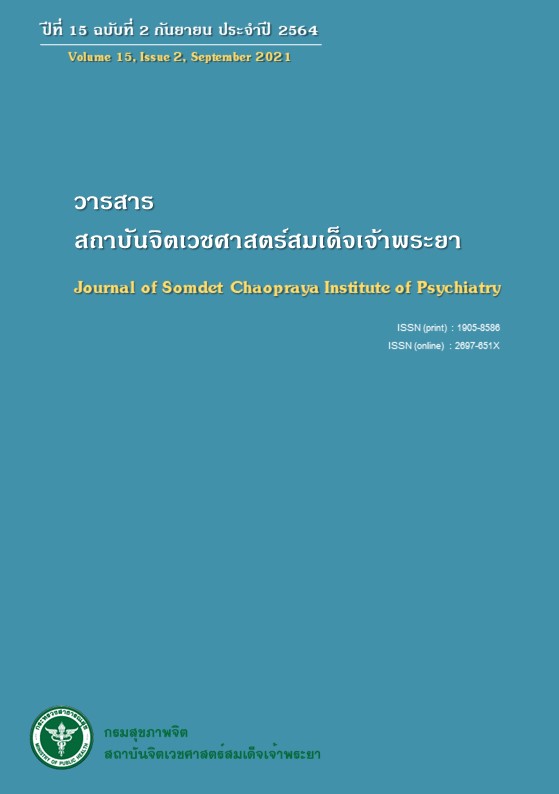การปรับปรุงและพัฒนาแบบประเมินปัญหาพฤติกรรม กลุ่มงานจิตวิทยา สถาบันราชานุกูล
คำสำคัญ:
แบบประเมิน, ปัญหาพฤติกรรม, พฤติกรรมบทคัดย่อ
วัตถุประสงค์ : เพื่อปรับปรุงและพัฒนาแบบประเมินปัญหาพฤติกรรม กลุ่มงานจิตวิทยา สถาบันราชานุกูล
วัสดุและวิธีการ : รูปแบบที่นำมาใช้ในการพัฒนาแบบประเมินปัญหาพฤติกรรม ฉบับปรับปรุงครั้งนี้ คือ การทบทวนวรรณกรรมที่เกี่ยวข้องเพิ่มเติม การรวบรวมปัญหานำส่งทางพฤติกรรมของผู้ป่วยที่เพิ่มเติมจากเดิม และประชุมผู้ปฏิบัติงานด้านจิตวิทยาคลินิกเพื่อสรุปผล สำหรับกระบวนการทางวิจัยที่ใช้พัฒนาแบบประเมินครั้งนี้ คือ การตรวจสอบความตรงเชิงเนื้อหาโดยผู้เชี่ยวชาญจำนวน 3 ท่าน การปรับแก้ตามข้อเสนอแนะของผู้เชี่ยวชาญ และภายหลังปรับแบบประเมินจึงดำเนินการหาค่าความเชื่อถือได้ ด้วยวิธีการหาค่าความเที่ยงระหว่างผู้สังเกต กับกลุ่มตัวอย่างจำนวน 36 ราย
ผล : แบบประเมินที่ผ่านการพัฒนาสามารถนำไปประเมินปัญหาพฤติกรรมกลุ่มตัวอย่างในช่วงอายุดังนี้ “3 - 5 ปี, 6 - 11 ปี, 12 - 18 ปี และ 18 ปีขึ้นไป” มีการปรับรายการประเมินจากเดิมแบ่งออกเป็น 7 กลุ่มพฤติกรรม ลดลงเพื่อความกระชับของแบบประเมินเหลือ 4 กลุ่มพฤติกรรม ผลการประเมินค่าความตรงเชิงเนื้อหาที่อยู่ในระดับยอมรับได้เป็นร้อยละ 66 (ค่า IOC > 0.5) ซึ่งมีข้อเสนอให้ปรับเนื้อหาและเกณฑ์ในข้อที่ “1.1-1.3, 3.1, 4.1, 4.2, 4.4, 5.4, 5.5” หลังการปรับตามข้อเสนอแนะผลจากการหาค่าความเชื่อมั่นโดยหาค่า reliability coefficient อยู่ที่ร้อยละ 86.96 ซึ่งเป็นระดับที่ยอมรับได้
สรุป : แบบประเมินที่ได้จากการปรับปรุงครั้งนี้นำไปใช้เป็นเครื่องมือประเมินปัญหาพฤติกรรมเด็กบกพร่องทางสติปัญญาที่มีปัญหาพฤติกรรมด้านต่าง ๆ ได้แก่ สมาธิและความสนใจ การกระตุ้นตนเอง พฤติกรรมก้าวร้าว และกลุ่มพฤติกรรมด้านสุขภาพจิตและจิตเวช
เอกสารอ้างอิง
Office of Sanatoriums and Healing Arts. Department of Health Service Support. Standards of Healing Practice in Clinical Psychology. 3rd ed. Bangkok: Art Chlorphite Company; 2014.
Taanila A, Ebeling H, Heikura U, Järvelin M. Behavioural problems of 8-year-old children with and without intellectual disability. J Pediatr Neurol 2003; 1: 15–24.
American Psychiatric Association. Diagnostic Statistical Manual, 4th ed. Washington, DC: American psychiatric publishing; 2000.
American Psychiatric Association. Diagnostic and statistical manual of mental disorders, 5th ed. Washington, DC: American psychiatric publishing; 2013.
Piyasil V. Textbook of Child and Adolescent Psychiatry. Bangkok: Beyond Publishing; 2002.
Vipulakorn P. 50th Anniversary book of Rajanukul. Bangkok: Rajanukul Institute; 2010.
Umpaipat A. Behavioural Modification Guideline. 3rd ed. Bangkok: Ladprao Publishing; 2005.
Achenbach TM, Rescorla LA. Manual for the ASEBA Preschool forms and Profiles. Burlington, VT: University of Vermont Department of Psychiatry; 2000.
Patel DR, Greydanus DE, Merrick J, et al. Introduction to intellectual and developmental disabilities. In: Rubin IL, Merrick J, Greydanus DE, et al. editors. Rubin and Crocker 3rd Edition: Health care for people with intellectual and developmental disabilities across the lifespan. Dordrecht: Springer; 2016.
Schalock RL, Borthwick-Duffy SA, Bradely VJ, et al. editors. Intellectual Disability: Definition, Classification, and Systems of Supports. 11th ed. Washington, DC: AAIDD; 2009.
Srivongpanit N, Intellctual Disability. In: Developmental texts and children’s behavior. Bangkok: Holistic Publishing; 2008.
Srivastava AK, Schwartz CE. Intellectual disability and autism spectrum disorders: causal genes and molecular mechanisms. Neurosci Biobehav Rev 2014; 46: 161-74.
Lloyd BP, Kennedy CH. Assessment and treatment of challenging behaviors for individuals with intellectual disability: a research review. JARID 2014; 27: 187-99.
Marielle CD, Russell JN, Stewart EE, Bruce JT, Hans MK. Assessing Emotional and Behavioral Problems in Children with Intellectual Disability: Revisiting the Factor Structure of the Developmental Behavior Checklist. J Autism Dev 2002;32.
Reichow B, Servili C, Yasamy MT, et al. Non-specialist psychosocial interventions for children and adolescents with intellectual disability or lower-functioning autism spectrum disorders: a systematic review. PLOS Med 2013; 10.
Alan E. Behavior Modification in Applied Settings. 6th ed. Illinois: Waveland Press, Inc; 2001.
Miltenberger RG. Behavior Modification Principle and Procedures. 3rd ed. U.S.A.: Thomson Wadsworth; 2004
Raymond G. Behavior Modification: Principles and Procedures. United States: Wadsworth; 2012.
Chuta PS, Siriphiboonphol A, Tawilo P. Guidebook for training in intensive behavioural modification curriculum (For psychologists target). Bangkok: Rajanukul Institute, Department of mental health; 2006.
Schacter D. Psychology. 2rd ed. US: Worth Publishers; 2011.
Kalish H. Learning: Principles and applications. New York: McGraw-Hill; 1981.
Chutha P. Development of Behaviour in Children with Delayed Development. Bangkok: Ladprao Publishing; 2006.
Chaninyuthwong V, Chutha P & Siriphiboonphol A. Developing the Evaluation of Behavior Problems, Psychological Service, Rajanukul Institute. J Psychiatr Assoc Thailand 2017; 62(4).
สุวิมล ว่องวาณิช. การวิจัยปฏิบัติการในชั้นเรียน. กรุงเทพฯ: จุฬาลงกรณ์มหาวิทยาลัย; 2546.
Karen Y. How to Increase Self-Control in Children – And Why It’s So Important for Their Success. [online]. Available from: www.heysigmund.com/how-to- increase-self-control-in-children/ [2017 Jun 5].
Sudi KG. The Development of Self-Control in Young Children. [online]. Available from: www.lej. cuchicago.edu/research-in-education/the-development -of-self-control-in-young-children/ [2017 Jun 5].
Ting Tao LW, Chunlei F & Wenbin G. Develop Development of self-control in children aged 3 to 9 years: Perspective from a dual-systems model. [online]. Available from: www.nature.com/articles/ srep07272 [2017 Jun 5].
ดาวน์โหลด
เผยแพร่แล้ว
รูปแบบการอ้างอิง
ฉบับ
ประเภทบทความ
สัญญาอนุญาต
บทความที่ได้รับการตีพิมพ์เป็นลิขสิทธิ์ของวารสารสถาบันจิตเวชศาสตร์สมเด็จเจ้าพระยา



